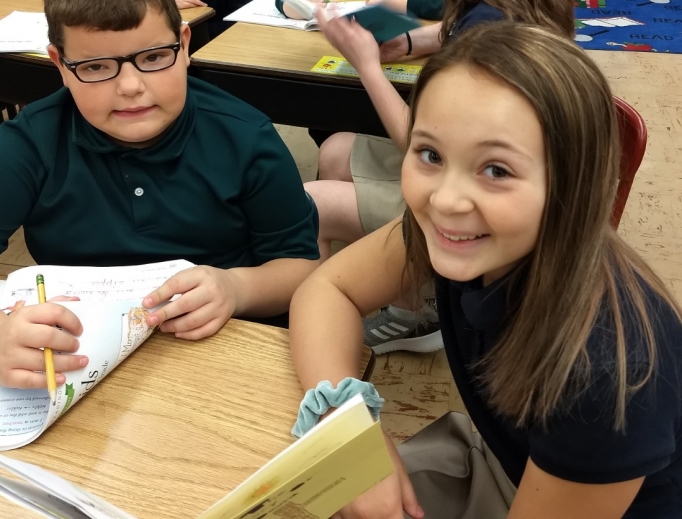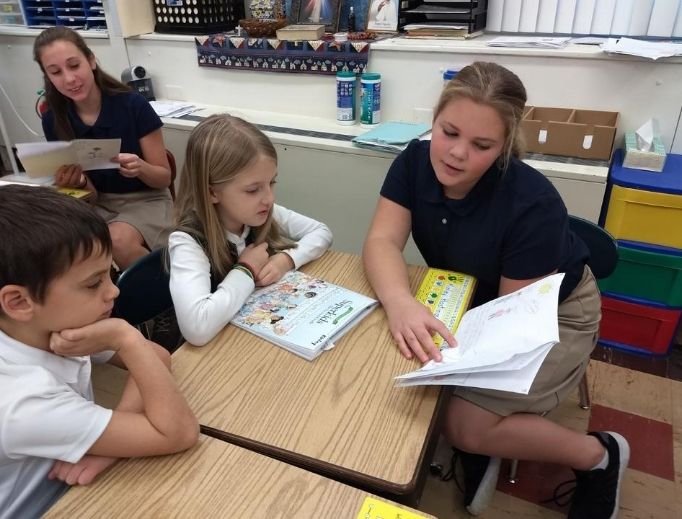New Trend: Implementing a Classical Catholic Curriculum
Diocese of Marquette Catholic schools are the first in the nation to adopt such a focus; high school to follow.

Catholic schools in the Diocese of Marquette, Michigan, have made a bold move to embrace an educational curriculum of the past to pave the way for a vibrant future. The diocese is the first in the nation to fully move all of its schools to a classical Catholic curriculum.
“We moved our schools toward this model because it best aligns with our mission as Catholic educators,” Mark Salisbury, Diocese of Marquette superintendent of Catholic schools, told the Register. “We know this because it is the model of education the Catholic Church has embraced through its history. It is the best curriculum to have all of the subjects lead our students to Christ.”
The diocese’s eight Catholic schools, which educate 1,100 students, began to implement a classical curriculum —which emphasizes truth, goodness and beauty and the study of the liberal arts (grammar, logic, rhetoric; arithmetic, geometry, music and astronomy; and Latin) and the great books. Overall, it focuses on helping students know how to learn and how to think. This classical curriculum was implemented during the 2014-15 school year, said Salisbury, and the results have been overwhelmingly positive, both in strengthening the uniquely Catholic educational experience for teachers, students and parents, but also in terms of maintaining enrollment.
“Our annual parent surveys consistently show that over 90% of our parents are either satisfied or very satisfied with our academic programs,” he said.
“Our curriculum has improved in many ways,” Salisbury explained, citing the curriculum features the incorporation of richer literature, new subjects like Latin and logic, and a new way of “teaching science through gardening and other outside nature experiences.” Other examples include “teaching history through a narrative approach and integrating the impact of the Catholic Church through history,” and “teaching theology of the body beginning at kindergarten.”
For Salisbury, the most impacting change is that all subjects are taught “through the lens of goodness, truth and beauty, which leads our students to Jesus,” he said.
Melissa Pillifant, middle-school math teacher at Father Marquette Catholic Academy (FMCA), one of the diocesan Catholic schools, agrees that pointing to Jesus Christ is the reason the classical curriculum is so successful: “When working to lead students to the good, the true and the beautiful, you are leading them to God, and he blesses you for that.”
Other school officials have experienced the same blessings.
“We are cultivating a unique love of learning with the students through a curriculum that is authentic and true,” said Michael Muhs, principal at St. John Paul II Catholic Academy (JPII) in Menominee. “[Parents] are appreciative that their children are gaining a depth of learning that they value and may not have received themselves years ago.”
Educational Edge
At Holy Name Catholic School — in the small community of Escanaba, a stronghold of Catholicism, with 35.7% of the population being Catholic — the classical curriculum has produced great results.
One positive indicator is the increase the school has seen in enrollment over the last several years. From 2008-09 to 2019-20, enrollment grew from 258 students to 329 students, an increase of 28%.

Principal Joseph Carlson said of the curriculum, “It is intended to bring more souls to know, love and serve Jesus.”
Michelle Bink, a Holy Name parent and school alumni/development director, says she feels having a classical Catholic curriculum provides practical benefits to students that provides an edge for their educational journey. “Students are encouraged to become deep thinkers and problem solvers, which is why many of our eighth-grade graduates become top 10 students in our local public high schools.”
Christy Miron, principal of Sacred Heart Catholic School in L’Anse, said her students have also excelled after graduation. “I always follow our Catholic school students’ academic successes after they leave here, and an overwhelming majority of students who graduate from Sacred Heart Catholic School continue to be honor-roll students in the public high schools. Also, we’ve had a number of parents choose us for their children’s education because of our classical curriculum rather than the Common Core taught in the public schools.”
Advantage of Classical Method
A unique part of the classical approach is that students learn Latin. According to Holy Name third-grade teacher Debra Casey, learning Latin has piqued her students’ interest in the English language.
“Latin is their favorite class,” she said. “They just love it!”
In their Latin classes, the students are not just memorizing words; they are learning their meanings and their connection to their Catholic faith and to the English language.
Principal Miron agrees that Latin has inspired students to learn even more about the English language — and science too.
“One of the beautiful aspects of teaching Latin is when an older student makes the connection between the Latin learned previously and a new word — often a scientific or academically-challenging word,” she told the Register. “They are able to discern the meaning of the word based on the Latin they’d already learned. Suddenly, the Latin becomes relevant, and you see their eyes light up as they grasp the implication of this.”
Miron says that her teachers, too, have embraced this classical model. “Our teachers have become experts at integrating various subjects with one another. For example, an art lesson on the geometry of trees includes elements of math and science.”
For Sacred Heart teacher Wendy Hiltunen, such an integrated curriculum offers students the “whole picture” and allows “a greater in-depth understanding.”
“For instance, I may begin the year with a unit on creation that will include the history of the Earth, the Bible creation story, scientific study of the planets, rocks, soils and plants,” she said. “I integrate math into the unit by focusing on geometric patterns, line and symmetry in nature, which leads nicely into artwork of creation, plants, animals, geometric shapes and models of the solar system,” she added, elaborating even further on how such lessons also lead to writing composition and even poetry.
Principal Muhs agrees that the curriculum provides an opportunity for teachers and students to dig deep into subjects.
“The depth of the content is one aspect of what makes the classical curriculum different. Within the classical model, we don’t just cover something in a cursory way; there is a depth to it,” he explained. “We dig into the content, and students are excited about it.”
As an example, the principal described a history lesson on medieval times at St. John Paul II Academy in which students built their own trebuchet catapult, integrating Science, Technology, Engineering, Art and Math (STEAM) concepts, as well as learning basic carpentry skills.
Said Muhs, “Ultimately, we must remember that learning is about wonder and discovery and learning the skills that free the mind.”
Principal Jessica Betz, of Father Marquette Catholic Academy in Marquette, agrees.
“Because of the classical curriculum, our students are inquisitive; they want to ask questions and to dig deeply into what they are learning,” she said. “Even more, they are given the time and space that they need to wonder about what they are learning. Learning is not rushed, but, rather, focused.”
For Principal Carlson of Holy Name Catholic School, the implementation of the Catholic classical model of learning is like the lifelong journey of faith. It is a process of conversion, with the final aim that “each day the goodness, truth and beauty is revealed a little more.”
Said Carlson, “We will always be learning more, going deeper and, ultimately, striving to become saints.”
Victoria R. LaFave has written for Today’s Catholic Teacher and for Holy Name Catholic School, The Bishop Noa Home and
The Bonifas Arts Center in Escanaba, Michigan. Several of her stories have been published in Chicken Soup for the Soul books.
MORE INFORMATION
To view a copy of the foundations document of the curriculum, visit DioceseofMarquette.org/catholicschools and click on the link at the bottom of the page.
Continuing the Vision
The success of this classical curriculum in the elementary schools has laid a strong foundation for the future of Catholic education in Michigan’s Upper Peninsula, which includes a centrally located classical high school to serve the entire diocese.
“We don’t see the kindergarten through eighth-grade classical curriculum as the end point,” Principal Joseph Carlson of Holy Name Catholic School, said. “We see it as momentum to reopen our former thriving high school. Our High School Planning Committee has taken the next step forward,” he said. “We’ve formulated a plan, and are well into our campaign, to expand our school to include a classical high school.” Carlson says the planning committee’s goal is to reopen Holy Name High School 50 years after it closed, in fall 2021.
Anne Carlson, Holy Name parent and high-school planning committee member, summarized the aim: “The benefits of a classical Catholic education cannot be understated.”
Principal Jessica Betz, of Father Marquette Catholic Academy in Marquette, agrees and encourages other principals who are considering implementing this classical curriculum to reach out to teachers and students who experience it.
“I think it is important for other schools to understand the magnitude of the classical curriculum by exploring the benefits,” she said. “To me, the best way to do this would be to speak to students and teachers who have experienced it and the beauty of it. It is incredible that through this classical curriculum and through the beauty of wonder, our students can be led directly to Christ and a deeper understanding of life.”
Given the schools’ achievements, as well as the Holy Name committee’s research on the importance of a Catholic high-school education for area children, Principal Carlson says he has faith in the Lord to make the high school a reality.
“We trust that the Lord will provide the means to make this happen, and with the continued support and leadership of Bishop John Doerfler and our superintendent, Mark Salisbury, I am confident that the doors of Holy Name High School will reopen,” he said. “We still have a way to go in fundraising, but we trust that if this is the Lord’s plan, he will touch people’s hearts and help us to get there. As faithful Catholics, we ask for your prayers for this endeavor. God has shown us every step of the way thus far, and we trust him to help provide us with the financial support we need.”
For more information, or to financially support the campaign, visit NowIsTheTimeHNHS.com or contact Holy Name Catholic School at (906) 786-7550.
— Victoria R. LaFave

















